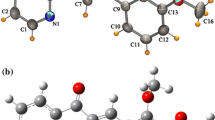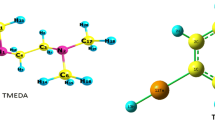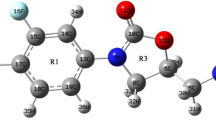Abstract
The simulation of molecular descriptors of thiophene-based metal complexes has been performed using Gaussian 03 and Atomistic toolkit Virtual Nanolab (ATK-VNL) software. It is found that with respect to the obtained molecular descriptors, the molecules show distinct properties. The dimensions of the data set being large, the principal components (PC1 and PC2) have been obtained using principal component analysis (PCA). Analysis has been done for the Linear regression of principal components with first hyperpolarizability and second hyperpolarizability of the molecules. The results indicate that, of all the calculated molecular descriptors of thiophene-based metal complexes, the molecular energy (E), ionization energy (EI), and molecular dipole moment (D) plays a dominant role in determining their nonlinear optical properties i.e., the hyperpolarizability value, of the studied molecules. Also, the molecular descriptors, polarizability (P) and molar refractivity (MR), show considerable impact on the nonlinear optical properties of the studied molecules.







Similar content being viewed by others
Availability of data and material
Not applicable.
Code availability
We have used Gaussian 03 and ATK-VNL software.
References
Chang DE, Vuletić V, Lukin MD (2014) Quantum nonlinear optics—photon by photon. Nat Photonics 8(9):685–694. https://doi.org/10.1038/nphoton.2014.192
Zyss, Joseph. Molecular nonlinear optics: materials, physics, and devices. Academic press, 2013.
Yin, Xiaobo, et al. "Edge nonlinear optics on a MoS2 atomic monolayer." Science 344.6183 (2014): 488–490. https://doi.org/10.1126/science.1250564
Lacroix PG, Malfant I, Lepetit C (2016) Second-order nonlinear optics in coordination chemistry: an open door towards multi-functional materials and molecular switches. Coord Chem Rev 308:381–394. https://doi.org/10.1016/j.ccr.2015.05.015
Liu X, Guo Q, Qiu J (2017) Emerging low-dimensional materials for nonlinear optics and ultrafast photonics. Adv Mater 29(14):1605886. https://doi.org/10.1002/adma.201605886
Dini Danilo, Calvete Mario JF, Hanack Michael (2016) Nonlinear optical materials for the smart filtering of optical radiation. Chem Rev 116(22):13043–13233. https://doi.org/10.1021/acs.chemrev.6b00033
Kalanoor Basanth S et al (2016) Third-order optical nonlinearities in organometallic methylammonium lead iodide perovskite thin films. Acs Photonics 3(3):361–370. https://doi.org/10.1021/acsphotonics.5b00746
Ejuh Geh Wilson et al (2016) Modeling of the electronic, optoelectronics, photonic and thermodynamics properties of 1, 4-bis (3-carboxyl-3-oxo-prop-1-enyl) benzene molecule. J Iran Chem Soc 13(11):2039–2048. https://doi.org/10.1007/s13738-016-0921-z
Karakas, A., et al. "Second-order hyperpolarizability and susceptibility calculations of a series of ruthenium complexes." 2013 15th International Conference on Transparent Optical Networks (ICTON). IEEE, 2013. https://doi.org/10.1109/ICTON.2013.6602901
Karakas Asli et al (2016) Ab-initio and DFT methodologies for computing hyperpolarizabilities and susceptibilities of highly conjugated organic compounds for nonlinear optical applications. Opt Mater 56:8–17. https://doi.org/10.1016/j.optmat.2016.01.036
Liu Yongjun et al (2001) Theoretical investigation on second-order nonlinear optical properties of (dicyanomethylene)-pyran derivatives. J Mol Struct 570(1–3):43–51. https://doi.org/10.1016/S0022-2860(01)00479-3
Powell CE, Humphrey MG (2004) Nonlinear optical properties of transition metal acetylides and their derivatives. Coord Chem Rev 248(7–8):725–756. https://doi.org/10.1016/j.ccr.2004.03.009
Ejuh, G. W., et al. "Prediction of electronic structure, dielectric and thermodynamical properties of flurbiprofen by density functional theory calculation." Karbala International Journal of Modern Science (2017). https://doi.org/10.1016/j.kijoms.2017.10.001
Nishal Vandna et al (2015) Optoelectronic characterization of zinc complexes for display device applications. J Mater Sci Mater Electron 26(9):6762–6768. https://doi.org/10.1007/s10854-015-3286-7
Serrano-Andrés Luis et al (2009) Linear and nonlinear optical properties of a series of Ni-dithiolene derivatives. J Chem Phys 131(13):134312. https://doi.org/10.1063/1.3238234
PereiraSilva PS et al (2014) Experimental and theoretical studies of the second-and third-order NLO properties of a semi-organic compound: 6-aminoquinolinium iodide monohydrate. Chem Phys 428:67–74. https://doi.org/10.1016/j.chemphys.2013.11.001
Nya, F. Tchangnwa, G. W. Ejuh, and J. M. B. Ndjaka. (2017) "Theoretical study of optoelectronic and thermodynamic properties of molecule 4-[2-(2-N, N-dihydroxy amino thiophene) vinyl] benzanamine: Influence of hydroxyl position." Mater Lett 202: 89-95. https://doi.org/10.1016/j.matlet.2017.05.064
Nouemo S et al (2015) Ab initio study of opto electric properties of the molecules pyrimethamine and sulfadoxine. J King Saud Univ Sci 27(4):349–355. https://doi.org/10.1016/j.jksus.2015.03.002
Anu, Anurag Srivastava, and Mohd Shahid Khan (2020) "Density functional theory calculations for electronic, optoelectronic and thermodynamic properties of dibenzothiophene metal complexes." Mater Res Express 7.1: 016311, DOI: https://doi.org/10.1088/2053-1591/ab6922
Anu, Anurag Srivastava, and Mohd. Shahid Khan. (2018) "First principle study of single electron transistor based on metal-organic complex of dibenzothiophene." Org Electron 53: 227–234. DOI: https://doi.org/10.1016/j.orgel.2017.11.042
Praveen, P. A., and R. Ramesh Babu. "Evaluation of nonlinear optical properties from molecular descriptors of benzimidazole metal complexes by principal component analysis." J Mol Graph Model 93 (2019): 107447. https://doi.org/10.1016/j.jmgm.2019.107447
Pearson, Karl. "LIII. On lines and planes of closest fit to systems of points in space." The London, Edinburgh, and Dublin philosophical magazine and journal of science 2.11 (1901): 559-572, DOI: https://doi.org/10.1080/14786440109462720
Wold S, Esbensen K, Geladi P (1987) Principal component analysis. Chemom Intell Lab Syst 2(1–3):37–52. https://doi.org/10.1016/0169-7439(87)80084-9
Abdi H, Williams LJ (2010) Principal component analysis. Wiley interdisciplinary reviews: computational statistics 2(4):433–459. https://doi.org/10.1002/wics.101
Ringnér M (2008) What is principal component analysis? Nat Biotechnol 26(3):303–304. https://doi.org/10.1038/nbt0308-303
Bro R, Smilde AK (2014) Principal component analysis. Anal Methods 6(9):2812–2831. https://doi.org/10.1039/C3AY41907J
Geladi, Paul, and Johan Linderholm. "Principal component analysis☆." (2020). https://doi.org/10.1016/B978-0-12-409547-2.14892-9
Ivosev G, Burton L, Bonner R (2008) Dimensionality reduction and visualization in principal component analysis. Anal Chem 80(13):4933–4944. https://doi.org/10.1021/ac800110w
Giuliani A (2017) The application of principal component analysis to drug discovery and biomedical data. Drug Discovery Today 22(7):1069–1076. https://doi.org/10.1016/j.drudis.2017.01.005
M. J. Frisch, et al. "GAUSSIAN 03 software package." Gaussian Inc., Wallingford (2004), accessed 15th March 2021.
Becke Axel D (1988) Density-functional exchange-energy approximation with correct asymptotic behavior. Phys Rev A 38(6):3098. https://doi.org/10.1103/PhysRevA.38.3098
Lee C, Yang W, Parr RG (1988) Development of the Colle-Salvetti correlation-energy formula into a functional of the electron density. Phys Rev B37(2):785. https://doi.org/10.1103/PhysRevB.37.785
Vosko SH, Wilk L, Nusair M (1980) Accurate spin-dependent electron liquid correlation energies for local spin density calculations: a critical analysis. Can J Phys 58(8):1200–1211. https://doi.org/10.1139/p80-159
Atomistic ToolKit-Virtual Nanolab. Quantumwise A/S. [Online]. Available: http:// quantumwise.com/. Accessed 12 April 2020.
Acknowledgements
The authors are thankful to Jamia Millia Islamia, New Delhi, for the computational facilities.
Funding
Institutional facilities supported the research.
Author information
Authors and Affiliations
Contributions
Anu performed the study and wrote the manuscript; AS and MSK guide and check the manuscript.
Corresponding author
Ethics declarations
Conflict of interest
The authors declare no competing interests.
Additional information
Publisher's note
Springer Nature remains neutral with regard to jurisdictional claims in published maps and institutional affiliations.
Rights and permissions
About this article
Cite this article
Anu, Srivastava, A. & Khan, M. Principle component analysis for nonlinear optical properties of thiophene-based metal complexes. J Mol Model 27, 340 (2021). https://doi.org/10.1007/s00894-021-04967-y
Received:
Accepted:
Published:
DOI: https://doi.org/10.1007/s00894-021-04967-y




